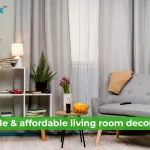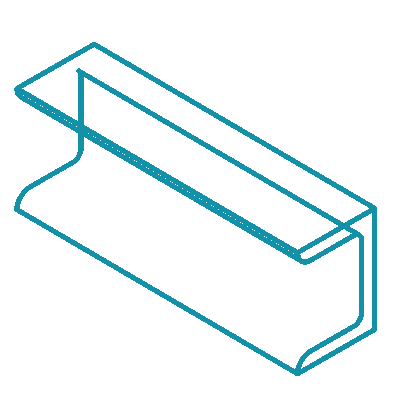
20 Affordable Living Room Decor Ideas For Every Budget
June 27, 2025
10 Creative Ways to Use Sliding Glass Doors in Small Apartments
June 30, 2025It is a normal scenario in India: the moment summer begins, electricity bills shoot up. No matter how much we shut the curtains, leave the fan and AC on all day, the rooms still feel like an oven.
Most of us don’t realise that our windows are the biggest reason for our homes to get so hot. In many homes, windows are made of regular glass that lets in 80% of the heat freely. So even if your AC is working, the glass is constantly undoing its effort.
But did you know that low-e (low emissivity) glasses can reduce energy loss by 30% to 50% and are perfect for summer?
Also read: 12 types of glass for windows you need to know about.
Low-E Glass For Hot Climates
Low-e glass is a standard clear glass with a super-thin invisible metallic coating that reflects heat and UV rays.
This coating is on one side of the glass, and it acts like a thermal mirror. It reflects infrared radiation (heat) and lets visible light pass through. This makes your home stay brighter and cooler.
Why Low-E Glass Is Suitable For Indian Homes?
India gets super hot during the summers. Most of the states deal with harsh sunlight for at least 8 months a year. Our homes absorb this heat through the roof, walls, and, most importantly, through the windows.
That’s why energy-saving windows, like low-e glass windows, are a smart upgrade.
- It blocks solar heat gain- It is helpful, especially in west or south-facing homes where sunlight is direct and harsh.
- It reduces glare- It makes indoor light softer without turning rooms dark.
- It cuts AC load- Your AC doesn’t have to fight the heat that pours in through regular glass.
- It keeps your furniture safe- It protects wood, upholstery, and curtains from fading due to UV exposure.
Low-e glass, more than just a comfort, is about long-term savings and durability.
How Much Can You Save? AC vs. Low-E Glass
A regular 1.5-ton AC consumes about 1.2 to 1.5 units per hour, depending on usage and efficiency.
At INR 8/unit, running it for 6 hours a day costs around INR 72/day. Monthly, it’s INR 2160/ month.
With low-e glass, indoor temperatures can drop by 4 to 8°C. For context, let’s say a 30% reduction in AC usage. That means spending INR 1500 or even less on cooling every month.
That’s a yearly saving of INR 7800 to INR 10000 for just one room. If you have more than one AC or use it more often, the savings are even higher. Also read: How do low-e glass windows work?
Types of Low-E Glass
Pyrolytic and sputter coated are the two types of low-e glasses. Based on your region, home design and needs, you can pick one.
Pyrolytic Low-E Glass (Hard Coat)
- It’s durable and slightly cheaper.
- It’s best for colder or mixed climates.
- It allows some solar heat to enter, which is good for winters.
Sputter Coated Low-E Glass (Soft Coat)
- It blocks heat more efficiently.
- It is ideal for Indian summers and hot regions.
- It is slightly costlier but performs better than the rest.
Which one should you pick?
If you want to reduce indoor heat and save on AC bills in Indian weather conditions, go for soft coat low-e glass, especially in combination with double-glazed units.
Where To Use Low-E Glass In Your Home?
To reduce heat, you need not replace every single window of your home with low-e glass. Use it in the
- Living room windows that face west or south
- Large glass doors or balconies that let in direct sunlight
- Skylights or roof glazing where heat pours in
- Glass facades or open-plan areas in duplexes and villas
Can You Combine It With uPVC Windows?
Yes. You can use low-e glass with uPVC window frames for superior energy-saving benefits. This combination works wonders in hot and humid Indian climates.
uPVC is naturally insulating and weather-resistant. You can expect zero corrosion, very little maintenance and 100% comfort.
Explore uPVC windows at GreenFortune.
How Much Does Low-E Glass Cost?
If you are wondering about the numbers, low-e glass typically costs more than regular glass. But the difference is not as high as most people assume, especially when you consider the long-term savings. It’s a one-time investment.
- Normal clear glass- INR 60 to INR 145 per sq. ft.
- Single-glazed low-e glass- INR 75 to INR 250 per sq. ft.
- Double-glazed low-e glass- INR 250 to INR 550 per sq. ft.
These are the average prices and can vary based on thickness, frame type, coating quality, and brand. For instance, premium low-e glass from global brands or custom-sized panels may cost more, around INR 500 to INR 1000 per sq. ft.
Also read: Creative glass window ideas for modern homes.
Is Low-E Glass Worth It?
With the high cost of low-e glass, if you wonder if it’s really worth it, we would say it’s 100% worth considering. While it’s a bigger investment upfront, it pays back quickly in the form of lower cooling bills, better comfort, and reduced AC usage.
FAQs
1). Can I install low-e glass in existing window frames?
Yes, you can install low-e glass in the existing window frame if the frame is in good shape. Many people replace just the glass and keep the frame. But if your windows are old or have gaps, it is better to upgrade the frame too.
2). Does low-e glass work with all window types?
Low-e glass works with all types of windows. Be it sliding, casement, fixed, tilt-and-turn, or even skylight windows, low-e glass can be retrofitted.
3). Is low-e glass eco-friendly?
Yes, low-e glass windows are eco-friendly windows because they reduce electricity consumption, heat gain, last long and are fully recyclable. Buying a low-e glass window is a sustainable choice.















